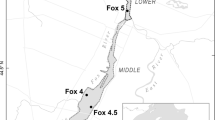Abstract
Plankton studies in Kachemak Bay, Alaska were combined with short-term sediment trap deployments in order to show the relationships of fluxes of Cu and Mn in organic particulate matter with biological processes occurring in the overlying water column. A large spring bloom decrease throughout the summer, due to decreasing nutrient levels and increasing grazing pressure by zooplankton. The concentration of organically bound Cu and Mn in the sediment trap particulate material increased throughout the summer reaching a maximum in August while fecal pellet production exhibited a similar increase. The fluxes of total particulate matter and organic carbon reached a maximum in June and represented a 30% increase over the corresponding fluxes in May. In contrast, the fluxes of organically bound Cu and Mn and fecal pellets in August represented 200%, 360% and 760% increases, respectively, over their respective fluxes in May. These results suggest that the enrichment of Cu and Mn in the organic particulate matter during August was a result of bioaccumulation of these metals into fecal material. The increase in the flux of the organically bound metals indicates a strong coupling between biological processes in the water column and their vertical transport. Thus, the production and subsequent sinking of fecal pellets may govern the transport of trace metals to the underlying water column and may also govern the transfer of a primary source of food and its associated trace metals to benthic communities.
Similar content being viewed by others
Literature Cited
Bishop, J. K. B., J. M. Edmond, D. R. Ketten, M. P. Bacon, andW. B. Silker. 1977. The chemistry, biology, and vertical flux of particulate matter from the upper 400 m of the equatorial Atlantic Ocean.Deep-Sea Res. 24:511–548.
Burbank, D. C. 1977. Circulation studies in Kachemak Bay and lower Cook Inlet. Alaska Dept. of Fish and Game, Anchorage, 207 p.
Chester, A. J., andJ. D. Larrance. 1981. Composition and vertical flux of organic matter in a large Alaskan estuary.Estuaries 4:42–52.
Chester, R., andS. R. Aston. 1976. The geochemistry of deep sea sediments.In J. P. Riley and R. Chester (eds.), Chemical Oceanography, 2nd Edition Academic Press, New York. 6:281–390.
Chipman, W. A., E. Schommers, andM. Boyer. 1968. Uptake, accumulation and retention of radioactive manganese by the marine annelid wormHermione hystrix. p. 3–16.In Radioactivity in the Sea Series, Publ. No. 25, International Atomic Energy Agency, Vienna.
Feely, R. A., G. J. Massoth, A. J. Paulson, M. F. Lamb, and E. A. Martin. 1981. Distribution in elemental composition of suspended matter in Alaskan coastal waters. NOAA Tech. Mem. ERL PMEL 27. Seattle, Washington. 119 p.
Fowler, S. W. 1977. Trace elements in zooplankton particulate products.Nature 269:51–53.
Gardner, W. D. 1980. Sediment trap dynamics and calibration: a laboratory evaluation.J. Mar. Res. 38:17–39.
Gatto, L. W. 1976. Circulation and sediment distribution in Cook Inlet, Alaska, p. 205–227.In D. W. Hood and D. C. Burrell (eds.), Assessment of Arctic Marine Environment. Selected topics. Occasional Publ. No. 4, Univ. Alaska, Fairbanks.
Hargrave, B. T., andS. Taguchi. 1978. Origin of deposited material sedimented in a marine bay.J. Fish. Res. Board Can. 35:1604–1613.
Honjo, S. 1978. Sedimentation of materials in the Sargasso Sea at a 5,367 m deep station.J. Mar. Res. 36:469–492.
Honjo, S., andM. R. Roman. 1978. Marine copepod fecal pellets: production, preservation and sedimentation.J. Mar. Res. 36:45–57.
Knauer, G. A., andJ. H. Martin. 1973. Seasonal variations of cadmium, copper, manganese, lead, and zinc in water and phytoplankton in Monterey Bay, CaliforniaLimnol. Oceanogr. 4:597–604.
Landing, W. M. 1978. The chemistry and vertical flux of particulate materials in the N.E. Gulf of Alaska. M.S. Thesis, University of Washington, Seattle. 102 p.
Landing, W. M., andR. A. Feely. 1981. The chemistry and vertical flux of particles in the northeastern Gulf of Alaska.Deep-Sea Res. 28:19–37.
Larrance, J. D., D. A. Tennant, A. J. Chester, andP. A. Ruffio. 1977. Phytoplankton and primary productivity in the northeast Gulf of Alaska.In Environmental Assessment of the Alaskan Continental Shelf, Environmental Research Laboratories, NOAA, Boulder, Colorado. 136 p.
Larrance, J. D., A. J. Chester, andH. B. Milburn. 1979. A new sediment trap and particulate flux measurements in lower Cook Inlet, Alaska.Mar. Sci. Com. 5:269–282.
Louma, S. N., and E. A. Jenne. 1977. The availability of sediment-bound cobalt, silver and zinc to a deposit-feeding clam, p. 212–231.In H. Drucker and R. E. Wildung (eds.) Biological Implications of Metals in the Environments, U.S. NITS Conf. 750929. Springfield, Virginia.
McCave, I. N. 1975. Vertical flux of particles in the ocean.Deep-Sea Res. 22:491–502.
Muench, R. D., H. O. Mofield, andR. L. Charnell. 1978. Oceanographic conditions in lower Cook Inlet: spring and summer 1973.J. Geophys. Res. 83:5090–5098.
Riley, J. P., andI. Roth. 1971. The distribution of trace elements in some species of phytoplankton grown in culture.J. Mar. Biol. Assoc. U.K. 51:63–72.
Sharp, J. H. 1974. Improved analysis for “particulate” organic carbon nitrogen from seawater.Limnol. Oceanogr. 19:984–989.
Spencer, D. W., P. G. Brewer, A. Fleer, S. Honjo, S. Krishnaswami, andY. Nozaki. 1978. Chemical fluxes from a sediment trap experiment in the deep Sargasso Sea.J. Mar. Res. 36:493–523.
Wiebe, D. H., S. H. Boyd, andC. W. Winget. 1976. Particulate matter sinking to the deep sea floor at 2000 m in the Tongue of the Ocean, Bahamas, with a description of a new sedimentation trap.J. Mar. Res. 34:341–354.
Wright, F. F., G. D. Sharman, andD. C., Burbank. 1973. ERTS-1 observations of sea surface circulation and sediment transport, Cook Inlet, Alaska, p. 1315–1322.In Proceedings of the Symposium on Significant Results Obtained from the Earth Resources Technology Satellite—1. National Aeronautics and Space Administration. Washington, D.C.
Author information
Authors and Affiliations
Additional information
Contribution No. 420 from the NOAA/ERL Pacific Marine Environmental Laboratory.
Rights and permissions
About this article
Cite this article
Feely, R.A., Chester, A.J., Paulson, A.J. et al. Relationships between organically bound Cu and Mn in settling particulate matter and biological processes in a subarctic estuary. Estuaries 5, 74–80 (1982). https://doi.org/10.2307/1352219
Issue Date:
DOI: https://doi.org/10.2307/1352219




